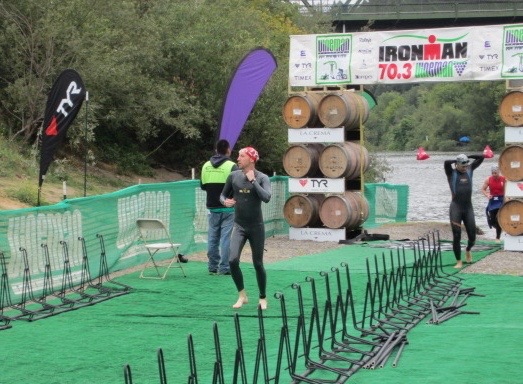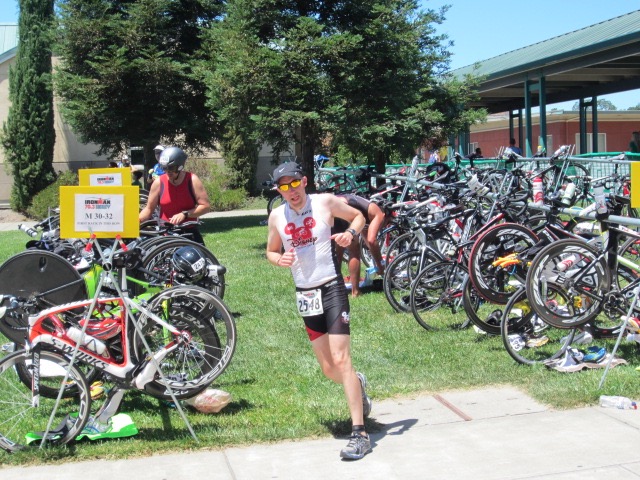|
The invitation came in early January of 2013: “Ironman Cozumel. December 1. You in?” Maybe it was the flurry of motivation that comes with every New Year, the “let’s make this year count” spirit that spurred the conversation. Or maybe it was just crazy talk. A Facebook invite gathered a group of members from the Disney Triathlon team for a destination race, but not just any race, an Ironman. Several on the invite had done Ironman races before. For a few of us, it would be our first time. As my friends accepted the invitation, the tiny voice inside my head insisted, “If you’re ever going to do the race, now is the time to do it. You won’t be alone.” So one chilly January evening, with my credit card in hand, I stared at the filled-out registration page. The computer cursor hovered over the REGISTER NOW button. I hesitated. In a Jekyll and Hyde moment, part of me started pleading for sanity, “You don’t want to do this!” The other half said, “Just F****** do it!” I clicked the button. Eleven months to Ironman. The race felt distant. An entire season of Major League Baseball will have started and completed by race day. Yet, there was still an underlying knot of urgency in my gut. This HUGE thing is coming. Am I ready? The answer was no, not at all. I called my coach and told him what I’d done. He asked me what my goal was. I said 1) to finish the race and 2) do it with my dignity intact - YouTube search for Ironman finishes and you’ll see some pretty harrowing videos. I didn’t want to collapse or crawl across the finish line. I wanted to finish strong. He promised me if I took my training seriously and did what he told me, I would accomplish my goal. We had a deal. There are two aspects to Ironman that make it so difficult. The first is the race itself, a grueling 140.6-mile test of endurance. The second is getting to the starting line healthy while enduring the training required to complete the race. Many arrive at the starting line injured, which makes the likelihood of a finish that much harder. My structured training program started the first week of March. I had nine months to prepare. The first five months weren’t so bad. It was familiar territory focused on building my fitness base, staying healthy, and orienting my life to the rhythms of training. And it is a life adjustment. Work. Train. Eat. Sleep. That is your life when you’re training for Ironman. At the beginning of August, four months to race day, I entered uncharted waters. The distances and durations of my workouts intensified. Most Saturdays involved an 80-100 mile bike ride. Sundays started with a one-hour swim and then a “short” two-hour ride. On Wednesdays, after a full day at work, I would put on my running shoes and go for a 10-15 mile run. Here is how a typical training week looked. The duration and intensity varied based on where I was in my training cycle. Monday: Rest Day Tuesday: Workout 1 – Bike Intervals Workout 2 – Swim Wednesday: Workout 1 – Long Run Thursday: Workout 1 – Bike Friday: Workout 1 – Strength Training Workout 2 - Swim Saturday: Workout 1 – Long Bike Sunday: Workout 1 – Swim Workout 2 - Bike During this time, I was always in a state of hunger. I would eat continuously. Everything within an arm’s length was fair game. I was always tired. My social life took a beating. “No, I cannot go out tonight. I need to sleep” became a mantra. Regular deep tissue massages were a necessity. The therapist would ask me, “What hurts? Is anything bothering you?” I would say, “Everything” before pulling my clothes off and climbing onto the table. One hot Saturday we did a 5-hour, 63-mile ride up into mountains. 6000+ feet of elevation gain. The temperature reading on my bike’s computer hit 114 degrees. You learn quickly on days like that how to take care of yourself, how to make decisions under stress. You learn how to get comfortable with being uncomfortable. By October, I had turned into a machine. Eat. Sleep. Train. Repeat. I had no emotional connection to what I was doing. I didn’t dread the workouts. I didn’t find satisfaction when they were complete. I felt nothing. Eat. Sleep. Train. Repeat. By November 1, one month to the race, I turned from robot to burnout. I hated my bike. I hated the stiffness in my right hip flexor that wouldn’t heal. I hated having to get up early in the morning when it was dark and cold and jumping into a swimming pool. I hated feeling like my body was broken all the time. Every workout at this point was an intense negotiation with myself. Part me pleading the case for training. The other part of me saying, “Screw it. I don’t want to do this anymore.” On one Saturday, a few weeks before the race, I was supposed to ride 100-miles. I was by myself that day. It was cold and drizzly. I was lonely and miserable. I rode 75-miles then went home. I told my coach I didn’t have it in my anymore. My coach assured me that what I was experiencing is what every person training for an Ironman experiences. Then he implored, “You’re almost there.” He was right and soon my training began to taper. Nine months of strength training, swimming, biking, and running now behind me. It was time to let my body recover and rebuild. Race day was here. July 2013. A couple pictures from the Vineman Ironman 70.3 race I did as a part of my Ironman training.
0 Comments
Leave a Reply. |
AuthorA WRITER AND TRAVELER KEEPING THE FAITH IN LOS ANGELES Subjects
All
Archives
August 2022
© 2022
|



 RSS Feed
RSS Feed